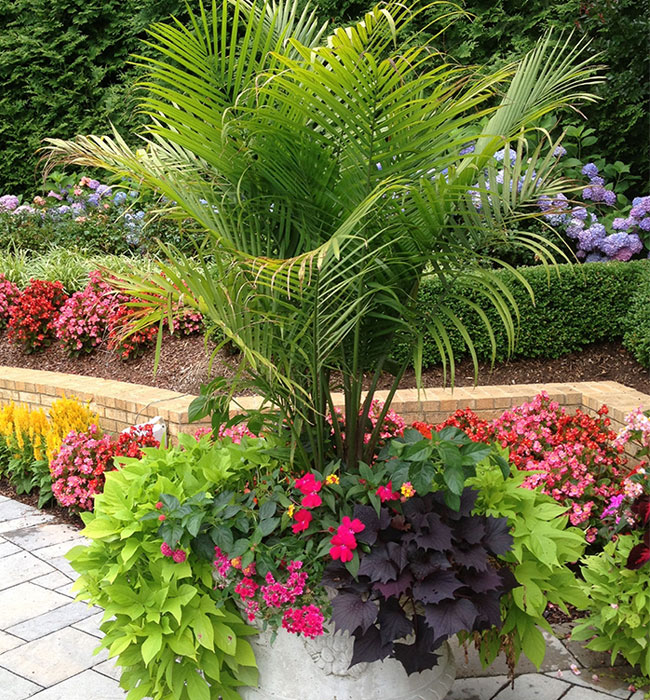
I get a lot of emails asking if palm trees can grow in containers. Yes, they can. In fact, many palms are great for growing in pots around pools, on patios, and on porches.
For many homeowners who live in colder climates, potted palm trees might be the only option to add an exotic and tropical feel to their outdoor area. When grown outside, potted palm trees have the same light, temperature, soil, and moisture requirements as they do when grown in the ground.
Since fast-growing palms will outgrow containers quickly, choose slow-growing palms that should be able to remain in the same container for two to four years. After that time, repot them into a larger container.
If you are planning on bringing them indoors during cold weather, look for palms that can tolerate low humidity and light levels. Ideal palm would be slow growing, small, very drought tolerant, adaptable to low humidity and light level,s and have a beautiful tropical appearance.
If you live in a warm area and are planning on keeping it outside all year round, then you don’t need to worry about humidity and light levels as much.
Best Palms for Growing in a Pot
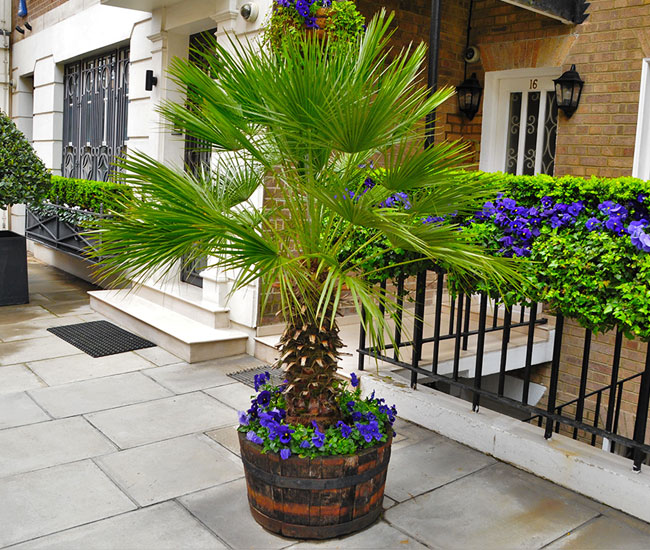
At the nursery, all palm seedlings are grown in a container until they are large enough to be introduced into the garden. While in a perfect environment, any palm can be grown in a pot, most palm species do much better in the ground.
Because it’s so hard to reproduce perfect conditions of drainage, nutrition, and water supply of palms grown in the garden, I recommend choosing palms that have historically done well in a container.
Also, some palms grow very fast quickly outgrowing one container after another. If not repotted into a larger container, the plant can become stunted. Palms can also become too tall for a container leading to instability during high winds and storms.
If the pot with soil is not heavy enough, the plant can easily blow over. Some of those fast-growing palms that are not best for container growth are the King Palm, Queen Palm, Carpentaria Palm, Acai Palm, Mexican Fan Palm, and Foxtail Palm.
The best palms to grow in a pot are the Majesty Palm, Pygmy Date Palm, Lady Palm, European Fan Palm, Sago Palm, Ponytail Palm, Bottle Palm, Jelly Palm, Fishtail Palm, etc.
What is the Best Soil for Potted Palms
While there are a lot of different potting soil mixes, there is no perfect solution for all palm species. Each gardener uses what works for them and what is available to him. That being said, don’t be surprised if your soil mix is completely different from a gardener across the US and both mixes work well.
One of the simplest mixes that many gardeners use is half peat moss and half perlite or coarse sand. It works well for young seedlings but is not that great in the long run. I recommend adding some topsoil and some coarse sand to it.
You can also just use well-draining potting soil with little organic matter, such as Miracle-Gro Cactus, Palm & Citrus Potting Mix. In general, any mix for succulents and cacti will work.
No matter what mix you use it should provide your palm with good drainage and support. The heavier the mix, the slower the drainage. The lighter the mix, the greater the drainage. Fine sand and topsoil slow the drainage while coarse sand, peat moss, and perlite increase the drainage.
When repotting the palm, make sure the pot has sufficient drainage holes to allow water to leave. In addition, I like to add some stones to the bottom of the container to improve the drainage. To minimize a ‘transplant shock’ when repotting a palm, I would keep the old soil around the roots of the plant.
How Much Sunlight Do Potted Palms Need
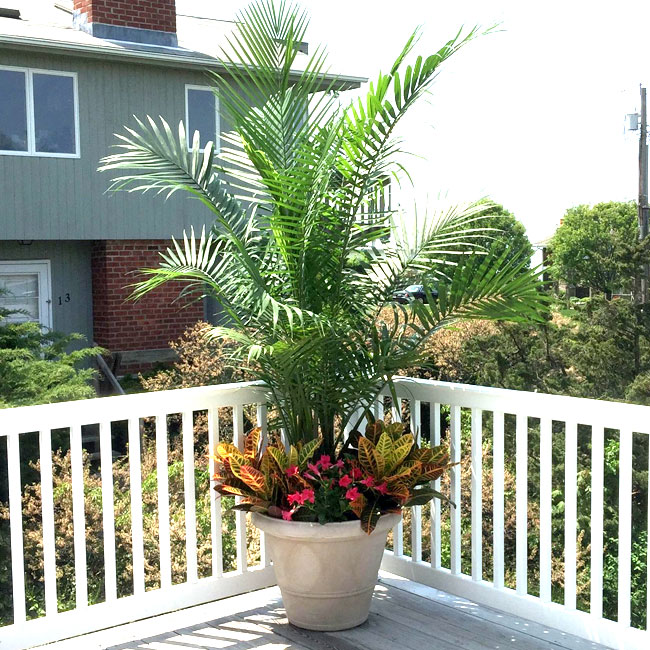
Different palms have different light requirements. Some need full sun and can tolerate partial shade, while others prefer shade and don’t do well in full sun. Also, as humidity levels lessen, many palms tolerate less direct sunlight.
A palm that can easily tolerate full sun in a tropical environment may need protection in a hotter area like the desert. On the contrary, palms that love dry and hot conditions will have difficulty adjusting to the tropical environment.
Before purchasing any palms, try to envision the type of palm you want and where you would place them. See if the area is getting full sun or full shade.
That will determine what type of palm you should get. Keep in mind, most young palms regardless of their light preference need to be protected from full sun until they are mature enough.
Also, if you’ve purchased a palm from a shade-grown environment, it is not used to full sun and needs to be acclimated first. To avoid a palm tree getting sunburned, acclimate it slowly by exposing it to higher light levels over four to six weeks.
You can do it by placing a potted palm in a shady spot and moving a little bit each week until it gets used to the sun. Another way is to put a potted palm in full sun under a plastic cover. Each week make a few holes to increase the light levels.
Watering Potted Palms
Outdoor container palms might get some water from the rainfall but generally depends on what you give them. Their roots don’t have an option of getting nutrition or water from the garden soil. Typically, potted palms tend to dry out much faster.
Water the palm until the water seeps out of the drainage holes. Let the pot drain for a half hour and then dump the excess water from the saucer. Repeat watering when the soil becomes nearly dry to the touch.
You can stick your finger an inch or so into the soil to check the moisture levels. If you are not a fan of getting your hands dirty, you can get a soil moisture meter. I personally hate to stick my fingers in the soil so I got a very inexpensive meter that I use all the time.
If the soil feels moist and cool, wait until it is drier before watering again. Don’t wait for the bottom soil in the pot to dry out. When watering my container plants, I use a watering wand that attaches to the hose. That way I can control the water dispersion instead of blasting the pot with water.
There is actually an irrigation system you can install that is designed for watering or deep watering potted plants. After figuring out the watering schedule, you can use the system to program it in.
It’s best to water container palms in the morning or evening when the sun is not too hot. Generally, palms require more frequent watering during the growing season when the conditions are dry or hot, and less frequent watering during winter when the temperatures cool down.
Because most palms come from humid climates, they enjoy occasional water misting during the dry season.
Salt Buildup in Soil
Salt buildup is one of the major problems for container palms. Most palm growers use well or city water which contains dissolved salt. After water evaporates from the soil it leaves salt behind.
Over time, salts from the water and fertilizers build up in the soil causing the plant to decline. One of the signs of salt buildup is the browning of the tips of the leaves. In more severe cases the bottom leaves will start to turn brown until only a few sick-looking leaves are left.
You can measure salt levels by using an inexpensive simple soil meter that checks soil pH. A perfect pH level for palm trees is between 6.5 to 6.8.
To drain out unwanted salts, water the palm ten times. This type of leaching should be done about two to three times a year depending on the severity of the buildup. The use of distilled or collected rainwater can help to slow down the buildup.
Fertilizing Potted Palms
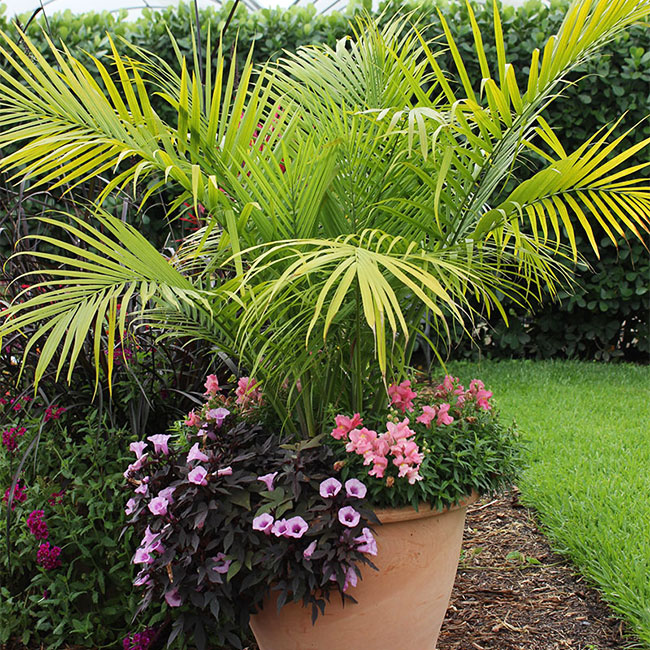
Palms growing in a container have a different fertilization routine than in-ground palms. Think about fertilizer not as food but rather as vitamins for the palm. It provides palm with needed nutrients for healthy growth and development.
The major nutrients for palms are nitrogen (N), phosphate (P), and potassium/potash (K). On the package, it often has just three letters NPK and the ratio of elements with three numbers like 3-1-3 or 12-4-12. There are also important microelements like iron, copper, zinc, manganese, and boron that should be present in the fertilizer or can be added separately.
For container palms, you want to use a balanced fertilizer with N and K in equal amounts. Some fertilizers that will also work, have NPK in nearly equal amounts. The higher the numbers the stronger the formula.
I prefer using a slow-release formula that feeds the palm for 6-9 months. Remember, less fertilizer will slow down the growth of the palm, too much fertilizer will kill it. It’s best to use fertilizer after you have leached the plant from all the salt buildup.
Always follow the instructions on the package and don’t forget to water your plant before applying it. Growing season is the best time of the year to fertilize your palm. If your area gets cold winters, avoid fertilizing after early fall. Fertilizing during winter months could promote new growth that can’t tolerate cold temperatures.
Pruning Potted Palms
Potted palms usually stay small for a long time, so you won’t need many pruning tools to keep them looking nice. Simple hand pruners or a regular utility knife can be used to trim small leaves, while ratchet lopper/lopping shears work great for larger fronds. But no matter what tools you use, always disinfect them after each plant.
If your palm has sharp teeth on the stems, remember to protect your hands with gardening gloves.
When pruning palms, you want to remove old brown leaves that are usually the lowest leaves of the canopy. Avoid removing green leaves since they are used by the palm for nutrients. When trimming the fronds, cut as close to the trunk as possible without hurting the trunk.
Leave leaf bases on the palm until they are ready to be removed. Forceful removal of leaf bases might cause permanent scars on the trunk. After a while, you can easily pull them off the trunk.
For a medium size container, will take just a few minutes to do cleaning and pruning of the leaves. Don’t forget to remove any unwanted weeds at the base of the plant.
Potted Palm Trees Garden Ideas
Container palms are a great addition to any deck, patio, porch, or pool area. Here are some pictures to give you an idea on how to incorporate potted palm trees into your outdoor living.
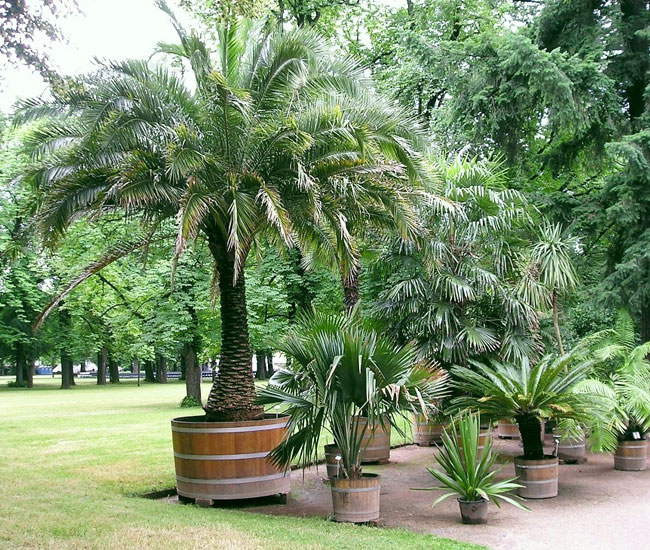
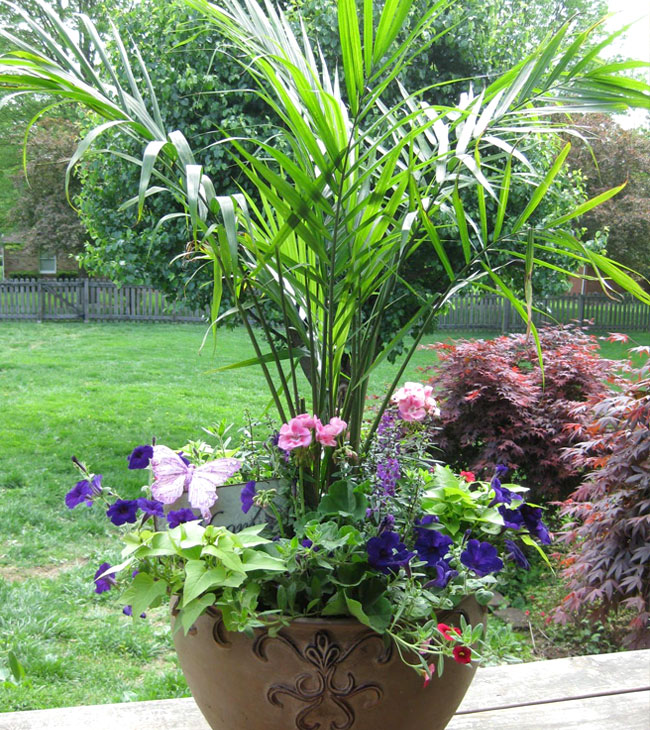
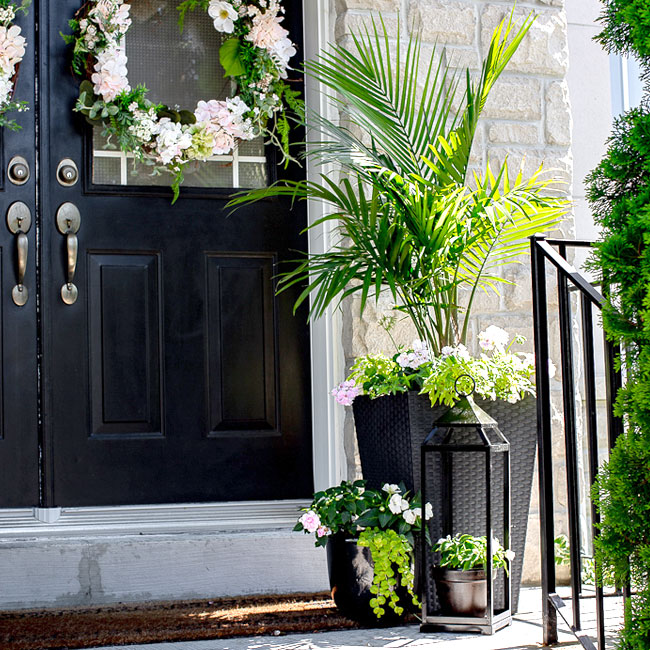
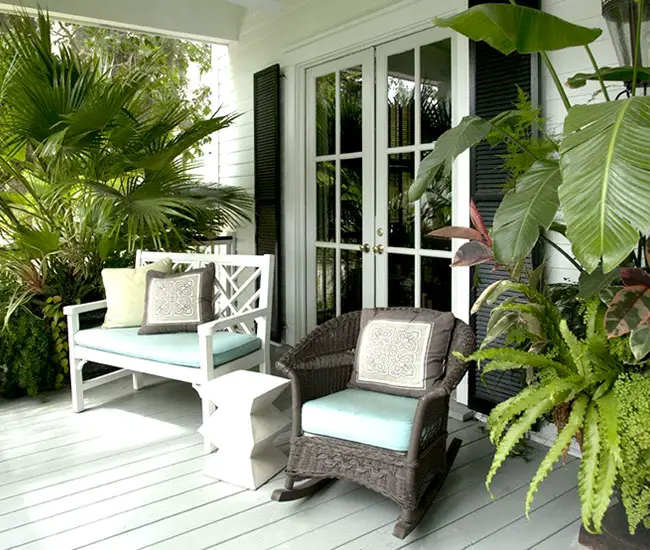
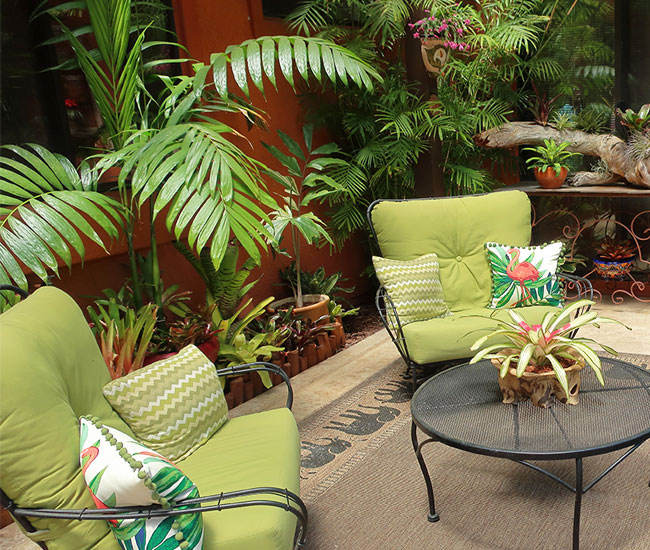
Related articles:
–How To Care For Indoor Palm Trees And Not To Kill Them
–Expert Advice: How to Prune a Palm Tree (with Pictures)
–Expert Tips: How To Water Palm Trees The Right Way
–How To Plant A Palm Tree In 10 Easy Steps (with Pictures)
